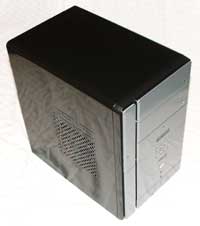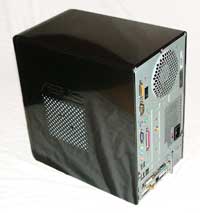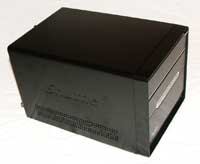Close Encounters of the Small Kind
by Jarred Walton on December 8, 2004 12:05 AM EST- Posted in
- Cases/Cooling/PSUs
Close Encounters
Writing for AnandTech puts me in something of a unique position. Few brick and mortar stores carry a large selection of SFF cases, and looking at pictures online doesn't always tell the whole story. With AnandTech, we have a large number of SFF units, many still waiting to be reviewed. (A SFF roundup will be coming soon, in case you were wondering. This is just a preface to the roundup.) The plan wasn't for me to begin using one of these cases as my own system initially, but system instabilities with one of my own computers caused me to change my mind. While I RMA the motherboard that is apparently causing problems and wait for its return, I decided to adopt one of the SFF cases for my own use - but which one?Understanding that aesthetics are a completely personal view, I checked out all of the cases. They all look pretty good, depending on your own taste - what I hate, someone is bound to love, and what I like, some will think is boring. In the end, I built two of the units just for purposes of a "test drive" and I picked what are basically the two extremes of the SFF genre.
 Click to enlarge. |
 Click to enlarge. |
On the one hand, we have the ASUS T2-P Deluxe. Depending on your point of view, it may not even qualify as a true SFF design. Featuring two CD/DVD slots, a 3.5" floppy bay - the floppy drive is actually included with the case - and an internal 3.5" HDD, not to mention a ton of other extras, the ASUS SFF includes everything and the kitchen sink. (The manual states that a CD/DVD drive is also included, but it was not present in this unit. This is possibly due to the fact that this unit was sent for review purposes, but it could also just be an error in the manual. We will try to get the official word from ASUS for the formal review; for now, it has a spare DVD-ROM in it.) Audio, fast Ethernet, USB2.0 and IEEE 1394a Firewire are pretty much standard features on any SFF. Add to that a six-in-one flash card reader, gigabit Ethernet, a radio tuner and antenna, integrated graphics, 802.11G wireless networking, and even serial and parallel ports, and you have a package that leaves little to be desired in terms of features. ASUS does limit your expansion options in one area, however. Many of the extras are included on a PCI add-in card, so your expansion card options are limited to adding an AGP graphics card.
 Click to enlarge. |
 Click to enlarge. |
The other unit is the latest from Shuttle, the XPC G5. Shuttle has been in this game longer than any other company, and after taking a look at all of the units stacked up, the design of their latest G5 model caught my eye. It's available in a few different formats: socket 775 with an 875P or 915P chipset and socket 939 with the Nforce3 250 Ultra chipset. Shuttle also has many other non-G5 XPC models that are worth checking out. Since the graphics card that would be used was an AGP model, PCI Express and the 915 chipset models were out of consideration. The system won't be used much for gaming, and the GPU would be the limiting factor anyway, so I ended up with the SB77G5 instead of the SN95G5. If I were actually to recommend an XPC model, I would choose the SN95G5 normally, but I wanted to try out a socket 775 system, as I had not yet done so. The features of the SB77G5 are similar to the ASUS T2-P Deluxe, only with less "extras". You get Firewire, USB2.0, Gigabit Ethernet, one 5.25" external bay, one 3.5" external bay, and one 3.5" internal bay. There's a good reason for the lack of extras, of course. The Shuttle XPC G5 is one of the smallest SFF cases out there.










45 Comments
View All Comments
henan - Tuesday, February 15, 2005 - link
I liked your article, even if it is something I would not buy unless I had lots of money to spare and wanted an extra toy. I like having the possibilities and as many of us I often install or just play around with a device, wich would not be as easy with an SFF.About that LPT port, as some suggest shuttle offers the addons. Another option would simply be to use a USB to LPT converter. About 20 dollars here in sweden. Why not a printserver? Many do have a home network setup. Of course you could spend that on a new printer, but why not use a printer that works? The converter will make it last until it finally brakes down (the enviroment issue...). Call me old fashioned, but I still use one!
/Henrik of Stockholm
willndowed - Tuesday, January 11, 2005 - link
I've got a shuttle SN45G system w/ a Athlon2800+, 1G of Ram... it was one with the 8X AGP port and I've got a 128M ATI 9600 video card in it.It's getting a little on the aged side, about a year old or so, but I've had nothing but good luck with it. It's been a great little machine. It's pretty good on overclocking, it' lets me OC the CPU to 3200+. It's got the ICE heat pipes that does a pretty darned good job of keep it cool.
I've done a few things to it, put a couple small 12v headlight tinting lights into it for case l ights and put a clear acrylic case on it. I've also put Battlefield on the front behind the acrylic front which gives it a little of a 3d look to it.
The real plus to this system is LAN parties. It's got a bag that fits it, so instead of making 3 or 4 trips hauling a 20 pound case huge monitor and a ton of other stuff... I load it into a bag, strap the keyboard and mouse to it, grab my monitor and go.
For the last year it's been a great machine...
... though I am going to build me a huge monster, this little system I'm going to keep it around.
RedWolf - Tuesday, December 14, 2004 - link
Nice article, Jarred. I completely understand about the little ones and the need to put the pc on the desk. I acquired an Antec Aria a month ago (traded a lanboy/mobo on the forums for it) and have been trying to make it better for high-end gaming.After lots of modding I got a BFG 6800 OC. Well, the 6800 was pretty loud, even at 50% speed. I bought an Artic Cooling VGA Silencer and it doesn't quite fit.
So, I gave up on the Aria as a high-end gaming case and will be moving my wifes component's into it.
I am looking into smaller atx cases now that have 120mm fans AND have a locking door on the front. That should keep little fingers away from the reset and power buttons. I guess I should have just taken my Lanboy and put it on my desk.
Anyway, I look forward to the SFF roundup you guys are doing. Don't forget to include the Aria and maybe even the Hornet.
flachschippe - Monday, December 13, 2004 - link
Talking about trends going to and fro:The Apple II of about 1978 *had* expansion slots. There was an enormous number of different cards available. It was said that the IBM PC's design
copied this aspect. Surprisingly, the first Apple Macintosh, of about 1984, was not user-upgradeable at all.
Phantronius - Monday, December 13, 2004 - link
As nice as SFF are, they simply just won't work for me. As frequently as I upgrade my equipment, my overhead costs and assache to upgrade using SFF would be a nightmare.I use Shuttle as workstations at work and build them for clients but for my gaming stations, I'll stick with ATX for a good long time.
flachschippe - Monday, December 13, 2004 - link
Talking about trends going to and fro:The Apple II of about 1978 *had* expansion slots. There was an enormous number of different cards available. It was said that the IBM PC's design
copied this aspect. Surprisingly, the first Apple Macintosh, of about 1984, was not user-upgradeable at all.
JarredWalton - Sunday, December 12, 2004 - link
Gioron - I just didn't want to be too hard on Shuttle when I haven't tried all of the other cases. The ASUS didn't give me any trouble, but maybe that was just luck, as I was using a different drive in that unit. I figure that many of the models with the drive covers are going to have some issues, and while Lian Li may have gotten it right, I haven't ever used one of their cases so I can't speak from personal experience.Anyway, it was about 10 minutes of work to get the drive positioned where it needed to be, so while annoying at the time it isn't a problem after assembly. Frequent upgraders would really have issues with most of the SFFs I've tried.
Gioron - Sunday, December 12, 2004 - link
err, correction: "adjusting the screws with the case open _and the computer turned on_"Gioron - Sunday, December 12, 2004 - link
Since I have an sn95g5 the one thing I was looking for (and found) in your article was mention of that dang CD drive button. I had the same problems getting the drive properly aligned, and personally feel that the tolerance is actually much less than 1/16" (though that might vary with the model of drive that you're installing). I eventually resorted to adjusting the screws with the case open, which is not exactly a good thing.In regards to your "there is no perfect solution" line about this, go find a lian-li case and one of its universal drive covers. The button is _under_ the drive plate, giving direct pressure to the CD's button and a much longer travel length and tolerance for misajustment. I see no reason (well, aside from possible patents or something) that Shuttle couldn't have coppied the same basic layout and put the drive button below and eliminated the funky lever system thats eating up most of the button travel distance and making the drive placement so difficult.
Of course, aside from that one minor pet peeve I'm happy with my SFF case, and feel the advantages are more than worth the limitations.
IceWindius - Saturday, December 11, 2004 - link
#35You gain some, and you loose some. Either use the onboard sound or stick with ATX.